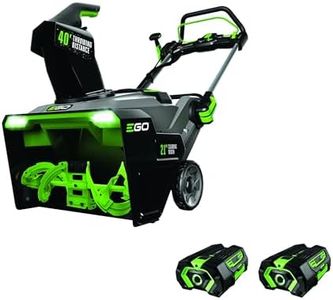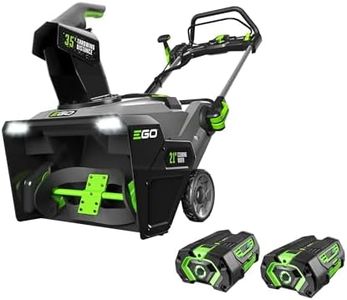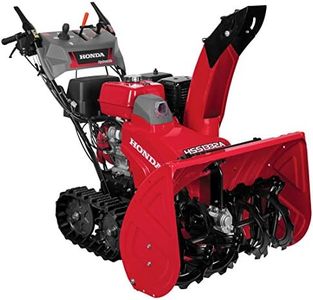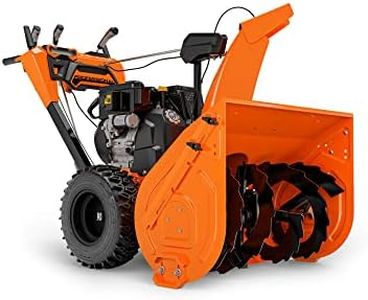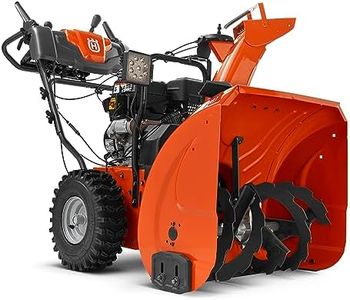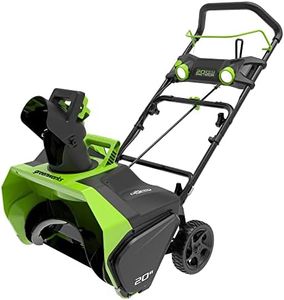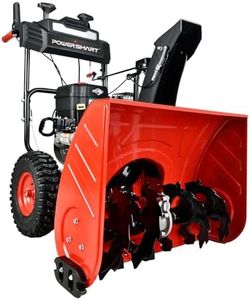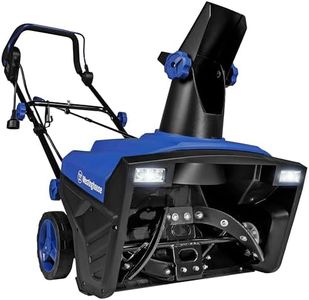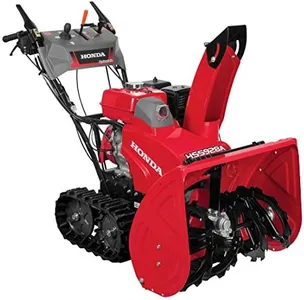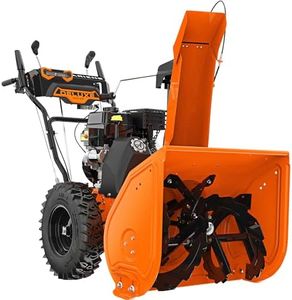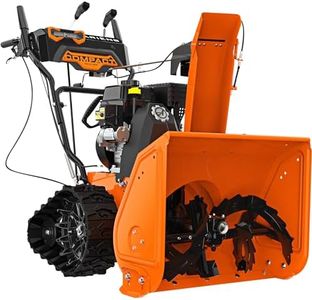10 Best Compact Snow Blower 2025 in the United States
Our technology thoroughly searches through the online shopping world, reviewing hundreds of sites. We then process and analyze this information, updating in real-time to bring you the latest top-rated products. This way, you always get the best and most current options available.

Our Top Picks
Winner
EGO Power+ SNT2112 21-Inch 56-Volt Lithium-Ion Cordless Snow Blower with Peak Power and Steel Auger - (2) 5.0Ah Batteries and Dual Port Charger Included
Most important from
2010 reviews
The EGO Power+ SNT2112 is a solid option for those seeking a compact and efficient snow blower. With a 21-inch clearing width, it covers a decent area in one pass, making it suitable for smaller driveways and walkways. The 56-volt lithium-ion battery ensures that you aren't tethered to a power cord, providing more freedom of movement.
Additionally, the Peak Power technology which combines the power of two batteries can be useful for tackling heavier snowfall. The steel auger is a strong feature, cutting through ice and snow significantly faster than some other models. This snow blower can throw snow up to 40 feet, which is quite impressive and helps in clearing large areas effectively.
Weighing 50.6 pounds, it is relatively lightweight compared to other snow blowers, making it easier to maneuver and handle. The high-efficiency brushless motor and variable speed auger control offer good performance and flexibility in different snow conditions. Also, the two LED headlights are a practical addition for those early morning or late evening snow removal tasks. On the downside, the ideal snow depth is up to 8 inches, which might not be sufficient for areas that experience heavy snowfall. Furthermore, being battery-powered, its operation time is limited by the battery life, so you might need to recharge or swap batteries for larger jobs.
In terms of build, it is weather-resistant with heavy-duty steel and composite construction, ensuring durability. The handle-mounted chute adjustment and quick-fold handle add to its convenience and ease of storage. This product is particularly beneficial for those with smaller properties or moderate snowfall conditions who prefer a cordless, easy-to-use snow blower.
Most important from
2010 reviews
EGO Power+ SNT2102 21-Inch 56-Volt Lithium-Ion Cordless Snow Blower with Peak Power - (2) 5.0Ah Batteries and Rapid Charger Included
Most important from
2010 reviews
The EGO Power+ SNT2102 is an impressive compact snow blower that offers a solid combination of features suitable for homeowners dealing with moderate snowfall. With a 21-inch clearing width and the capability to clear up to 8 inches of snow, it performs well for residential driveways and sidewalks. One of its standout features is the peak power technology that uses two 56-volt batteries, which enhances its performance and allows for a throwing distance of up to 35 feet, making it efficient for clearing a good-sized area.
The weather-resistant design and robust steel construction contribute to its durability, while the high-efficiency brushless motor ensures a quieter operation compared to gas-powered alternatives. The push-button start and variable-speed control are user-friendly, making this snow blower accessible for those who may not be very tech-savvy. Additionally, the built-in LED headlights improve visibility during early morning or late evening clearing.
Weighing in at about 50.7 pounds, it may be a bit heavy for some users, especially if lifting is required for storage or transport. While the battery life is generally good, clearing larger areas or deeper snow may require additional battery power or charging time. As a battery-operated model, it may have less power than some larger gas-powered snow blowers, which could be a consideration for those in areas with heavy snowfall. The EGO Power+ SNT2102 is a great choice for those looking for a compact, efficient, and environmentally friendly snow blower for residential use. It's particularly suitable for average snow conditions and smaller properties, but potential buyers should consider their specific clearing needs and the possibility of needing additional battery support.
Most important from
2010 reviews
Honda HSS1332ATD 389cc 32 inch Track Drive Two Stage Snow Blower, Electric Start
Most important from
27 reviews
The Honda HSS1332ATD is a powerful two-stage snow blower designed for tackling heavy snowfall, making it a solid choice for homeowners in areas with significant winter weather. One of its standout features is its impressive 32-inch clearing width, allowing you to cover a large area quickly. The 389cc Honda GX OHV engine provides robust power, enabling it to clear up to 2750 pounds of snow per minute and throw it an impressive distance of up to 56 feet, which is beneficial for clearing driveways and paths without needing to constantly reposition the machine. The electric start feature adds convenience, especially on those cold mornings when you want to get out and clear snow quickly.
On the downside, this snow blower is relatively heavy, which could make it challenging for some users to maneuver, especially in tight spaces. It's also gasoline-powered, meaning you'll need to handle fuel, which might not appeal to everyone, especially those who prefer electric models for their ease of use and lower maintenance. Additionally, while it's built to handle tough conditions, its size and weight may make it less suitable for those with smaller yards or who do not experience heavy snowfall regularly.
The Honda HSS1332ATD excels in performance and efficiency for serious snow removal tasks. It's best suited for users who need a reliable and powerful machine capable of handling deep snow, while those with lighter snow conditions or smaller areas might find it a bit cumbersome.
Most important from
27 reviews
Buying Guide for the Best Compact Snow Blower
Choosing the right compact snow blower can make a significant difference in how efficiently and comfortably you can clear snow from your driveway, sidewalks, and other areas. When selecting a snow blower, it's important to consider several key specifications that will determine how well the machine will perform in your specific conditions. Understanding these specs will help you make an informed decision and ensure you get the best fit for your needs.FAQ
Most Popular Categories Right Now
